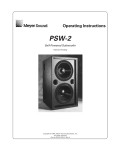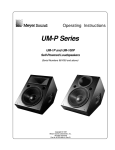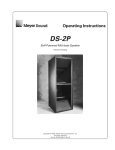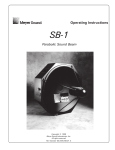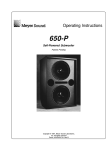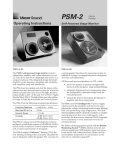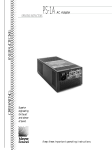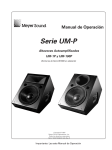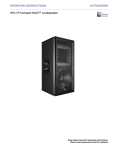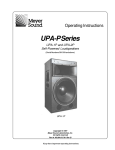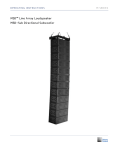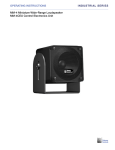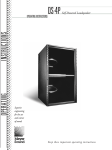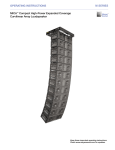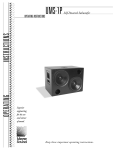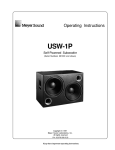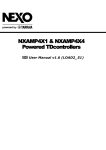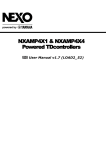Download Operating Instructions
Transcript
Operating Instructions LD-1A Line Driver Patents Pending CH 1 Signal CH 2 Mute-Clip Signal CH 3 Mute-Clip Signal CH 4 Mute-Clip Signal CH 5 Mute-Clip Signal CH 6 Mute-Clip Signal CH 7 Mute-Clip Signal CH 8 Mute-Clip Signal Mute-Clip Mute Mute Master -3 -6 -9 -12 LD-1A Line Driver 0 +3 Mute +6 +- 15V DS-2 -3 -6 -9 -12 +3 Array EQ Sub 0 +6 -3 -6 -9 -12 -3 -6 -9 -12 0 φ 0 +3 Mute +6 +6 DS-2 -3 -6 -9 -12 0 +6 Master -3 -6 -9 -12 0 Mute Master -3 -6 -9 -12 +3 +6 0 Mute Active -3 -6 -9 -12 +6 0 Master -3 -6 -9 -12 φ Polarity +6 0 Mute +3 180 0 Mute Master +3 +6 0 -3 -6 -9 -12 Master +3 +6 Mute Mute -3 -6 -9 -12 0 Master -3 -6 -9 -12 +3 +6 0 +3 +6 Crossover φ Lo Cut Lo Cut Array EQ Array EQ Sub DS-2 & Sub Lo Cut Out Mute Sub +3 +3 Sub Mute -3 -6 -9 -12 0 Mute DS-2 & Sub Crossover Array EQ Mid-Hi +3 φ DS-2 Lo Cut Mute Sub +3 Master +6 DS-2 & Sub Crossover Mute -3 -6 -9 -12 0 Lo Cut Power Mid-Hi φ DS-2 Mute +3 Lo Cut Lo Cut Lo Cut Lo Cut Array EQ Array EQ Array EQ Array EQ In Array EQ Out +6 In LD-1A Front Panel Channel 5 Channel 3 Channel 1 PUSH PUSH PUSH Channel 7 CAUTION: Set voltage before applying power. PUSH AC Voltage Ranges ~ ~ 180-250V 90-125V Input Mid-Hi Out DS-2 Out PUSH Sub Out Loop Input Output Input Output PUSH PUSH Input Output PUSH CAUTION: RISK OF FIRE REPLACE WITH T250mA - 250V FUSE ~ 90-125/180-250 V 50-60 Hz 25W MAX Channel 2 Channel 4 Channel 6 LD-1A Rear Panel Copyright © 1997 Meyer Sound Laboratories, Inc. All rights reserved Part #: 05.037.002.01 Rev B2 Channel 8 Symbols Used These symbols indicate important safety or operating features in this booklet and on the chassis. ! Dangerous voltages: risk of electric shock Important operating instructions Frame or chassis Protective earth ground Pour indiquer les risques rÈsultant de tensions dangereuses Pour indequer important instructions Masse, ch‚ssis Terre de protection Zu die gefahren von gef‰hrliche spanning zeigen Zu wichtige betriebsanweisung und unterhaltsanweisung zeigen Rahmen oder chassis Die schutzerde Para indicar azares provengo de peligroso voltajes Para indicar importante funcionar y mantenimiento instrucciones Armadura o chassis Tierra proteccionista Declaration of Conformity According to ISO/IEC Guide and EN 45014 The Manufacturer: declares that the product: Product Name: LD-1A Product Options: All Name: Meyer Sound Laboratories Address: 2832 San Pablo Avenue Berkeley, California 94702-2204, USA conforms to the following Product Specifications: Safety: EMC: EN 60065: 1994 EN 55022: 1987 IEC 801-2: 1984 IEC 801-3: 1984 IEC 801-4: 1984 - Class A 8 kV 3 V/m 0.5 kV Signal Lines, 1.0 kV Power Lines The product herewith complies with the requirements of the Low Voltage Directive 73/23/EEC and the EMC Directive 89/336/EEC. Office of Quality Manager Berkeley, California USA April 1, 1997 Environmental Specifications for Meyer Sound Electronics Products Operating temperature: 0 C to +45 C Non-operating temp: < ñ40 C or > +75 C Humidity: to 95% at 35 C Operating altitude: to 4600 m (15,000 ft) Non-operating altitude: Shock: to 6300 m (25,000 ft) 30 g 11 msec half-sine on each of 6 sides 10 ñ 55 Hz (0.010 m peak-to-peak excursion) Vibration: Made by Meyer Sound Laboratories Berkeley, California USA U ® L UL LISTED 3K59 C ® COMMERCIAL AUDIO SYSTEM European Office: Meyer Sound Lab. GmbH Carl Zeiss Strasse 13 56751 Polch, Germany Contact Information Meyer Sound Laboratories, Inc. 2832 San Pablo Avenue Berkeley, California 94702 Telephone: 510 - 486 - 1166 FAX: 510 - 486 - 8356 E-mail: [email protected] www.meyersound.com 2 Meyer Sound Germany GmbH Carl Zeiss Strasse 13 D-56751 Polch, Germany Telephone: 49.2654.9600.58 FAX: 49.2654.9600.59 Email: [email protected] Contents LD-1A Signal Flow Diagram................................ Introduction ......................................................... Audio Input ......................................................... AC Power ............................................................. Main Channels 1 and 2 ........................................ 3 4 4 4 5 Auxiliary Channels 3-8 ............................................ 6 Example Configurations .......................................... 7 Safety Summary ..................................................... 9 Specifications ....................................................... 10 LD-1A Signal Flow Diagram GRN RED LED SIGNAL & CLIP DETECTOR MUTE SWITCHES XLR Common mode: 425 kHz low-pass 80 dB CMRR Laser Trimmed Normal mode: 142 kHz low-pass 3 Input 10 kW 2 1 Master Level Master Mute Switch DIFF AMP fc RF & ESD FILTER Earth and Chassis GND -12 to +6 dB Audio GND 10 W on power supply board Channels 1& 2 only Full range Flat Mid-Hi Level High Current Mid-Hi Mute Switch XLR DIFFERENTIAL DRIVER Low-cut 160Hz Q=0.8 -12 dB/oct ArrayEQ PWR-ON PWR-OFF MUTE RF BLOCK 3 2 -12 to +6 dB Ð6 dB at 220Hz; 0.6 octave bandwidth Mid-Hi Output 1 Earth and Chassis GND Channels 1& 2 only High Current DS-2 Level Full range DS-2 Mute Switch XLR DIFFERENTIAL DRIVER Crossover PWR-ON PWR-OFF MUTE RF BLOCK 3 2 Polarity inverted -12 to +6 dB 80Hz Elliptical Polarity normal 1 DS-2 & Sub Crossover DS-2 or 2nd Sub Output Earth and Chassis GND High Current Sub Level Full range Polarity normal XLR DIFFERENTIAL DRIVER Crossover -12 to +6 dB 65Hz Q=0.9 -12 dB/oct Sub Mute Switch Polarity inverted PWR-ON PWR-OFF MUTE RF BLOCK 3 2 Sub Output 1 Earth and Chassis GND 3 Introduction Audio Input The Meyer LD-1A Line Driver combines functions previously accessed on the control electronics units for externally amplified Meyer loudspeakers with new features, and locates them in a self-contained device accessible to the sound engineer during setup and performance. The LD-1A The LD-1A presents a 10 kOhm balanced input impedance to a three-pin XLR connector wired with the following convention: • integrates different types of Meyer self-powered speakers into a full-range main system; • provides gain, mute, and optimized EQ controls for six auxiliary systems; • maintains signal integrity for long cable paths. Channels 1 and 2, equipped to control the main system, each have: • a gain control, mute switch, and crossover function; • separate Mid-Hi, DS-2 (mid-bass), and Sub output controls; • a male XLR Loop connector to route the input signal to an auxiliary channel or another device. The six auxiliary channels (3–8) control down-fill, frontfill, and delay systems. Auxiliary channels can also be used to divide a main system into subsystems, allowing independent signal levels for speakers directed at different audience locations. Each auxiliary channel has a mute switch, gain control, and Lo Cut and Array EQ filters. All eight channels are fully independent from each other. The LD-1A occupies two rack spaces and is constructed with a 16-gauge steel chassis and 1/8” aluminum rack ears. This rugged design provides protection from accidental impact, magnetic isolation from nearby devices, and EMI immunity. Meyer Speaker Types The following Meyer self-powered speakers are mentioned in this document. MSL-4 Self-powered mid-hi speaker CQ Series Self-powered mid-hi speaker DS-2P 4 Self-powered mid-bass speaker 650-P Self-powered subwoofer PSW-2 Self-powered subwoofer Case — Earth (AC) ground and chassis Pin 1 — Earth (AC) ground and chassis Pin 2 — Signal Pin 3 — Signal Differential Inputs The LD-1A is balanced in and out, and consequently has no hot (+) pin. Pins 2 and 3 carry the input as a differential signal. Use standard audio cables with XLR connectors for balanced signal sources. The audio input signal should always be applied between pins 2 and 3. Pin 1 is connected to chassis and acts as a safety and current bleed to earth for the EMI and ESD interference coupled onto the shield of the input cable. Pin 1 is therefore a noisy ground, and connecting an audio signal between pins 1 and 2, or pins 1 and 3, results in a noisy audio signal. Most modern balanced audio sources (electronically balanced or transformer output) conform to the wiring convention described above and interface correctly with the LD-1A. However, an audio source may produce noise if it connects pin 1 to a quiet internal audio ground, and is then connected to pin 1 of the LD-1A (chassis/earth). To alleviate this noise, try disconnecting pin 1 (or the cable shield) of the audio source. To connect an unbalanced audio source to the LD-1A, use the following wiring connections: RCA output RCA output jack LD-1A input LD-1A XLR input XLR jack – – + + –– Tip is is is Tip is Ring Ring positive positivenegative negative terminal terminalterminal terminal 3 2 •• •• 1 3 2 1 chassis/earth chassis/earth terminal terminal shield shield Connect shieldtoto– – terminal (ring Connect shield terminal (ring) ififthe equipment is floating the source source equipment is floating. Do connectthe theshield shield if the Do not not connect if the source is grounded. grounded. source is AC Power Main Channels 1 and 2 AC Inlet and Voltage Select Switch Channels 1 and 2 are equipped to control a full-range main system. Each channel has a Signal/Mute-Clip LED indicator, mute switch, gain control, Mid-Hi, DS-2, and Sub output controls, and a male XLR Loop connector. The LD-1A uses an international standard IEC 320 Mains AC inlet. This convenient rear panel receptacle accepts many power cord types for mains outlets used throughout the world. The LD-1A must have the correct power cord for the AC power in the area in which it will be used. The LD-1A operates in two AC voltage ranges: 90 – 125 V and 180 – 250 V, at 50 or 60 Hz. The voltage select switch on the rear panel must be set to the proper voltage before applying AC power. Connecting the LD-1A to a 225 V AC source with the voltage select switch in the 90 – 125 V position could blow the fuse. Unplug the power cord before changing the voltage select switch! CH 1 Signal Signal Mute Master -3 -6 -9 -12 0 +3 Mute +6 DS-2 -3 -6 -9 -12 AC Voltage Ranges ~ 90-125V ~ 180-250V Voltage select switch CAUTION: RISK OF FIRE REPLACE WITH T250mA - 250V FUSE ~ 90-125/180-250 V 50-60 Hz 25W MAX IEC 320 male power inlet The audio outputs are muted internally during normal power on and off, and in case of sudden loss of AC power or unstable line voltage. This precaution prevents noise transmission, and possible damage, to interconnected devices. -3 -6 -9 -12 0 +3 Lo Cut Array EQ Sub 0 +3 +6 Mute Master -3 -6 -9 -12 -3 -6 -9 -12 0 φ 0 Mute +6 +3 +6 DS-2 -3 -6 -9 -12 -3 -6 -9 -12 +6 +6 φ Mute Sub +3 +3 Sub Mute 0 0 DS-2 & Sub Crossover Array EQ Mid-Hi φ DS-2 +3 Lo Cut Mute Sub Mute-Clip +6 DS-2 & Sub Crossover Mute Mid-Hi φ DS-2 CAUTION: Set voltage before applying power. CH 2 Mute-Clip -3 -6 -9 -12 0 +3 +6 The Master gain control sets the channel’s overall level. The Mute switch mutes the entire channel. The bicolored Signal/Mute-Clip LED indicates input signal presence and level with a variable intensity green color, and clipping or mute with red. The Loop connector is used to send the input signal to an auxiliary channel or to another device. The Mid-Hi, DS-2 (mid-bass), and Sub outputs each have a level control and mute switch. The level control modifies the level set by the channel’s Master gain control; the mute switch affects the Mid-Hi, DS-2, or Sub output only. For example, the Mid-Hi output could be muted without affecting the Loop, Sub, or DS-2 outputs. Additional functions specific to each output are described in the following sections. Donít use a ground-lifting adapter or cut the AC ground pin. To avoid electrical shock and damage to the unit, use the power cord specified by Meyer Sound or an equivalent that satisfies the requirements of the local safety testing agency. Do not operate the unit if the power cables are frayed or broken. AC Fuse Always disconnect the power cord before changing the fuse. To replace the fuse, insert a flat-blade screwdriver in the fuse cap and gently turn counterclockwise; the fuse springs from its socket. Replace only with a 5 x 20 mm, T 250 mA, 250 V, time-lag fuse that conforms to identical safety agency standards. If the fuse blows again, contact Meyer Sound for repair information. 5 Mid-Hi Output The Mid-Hi output has two switch-activated, optimized filters. Pushing the Lo Cut switch in activates a highpass filter (160 Hz, Q = 0.8, –12 dB/octave) that performs a crossover function for the Mid-Hi output. The filter is bypassed with the switch out. Pushing the Array EQ switch in activates a filter (6 dB cut at 220 Hz, 0.6 octave bandwidth) to equalize the lowmid rise produced by three to five horizontally arrayed MSL-4s. The filter is bypassed with the switch out. NOTE: The Array EQ filter compensates for MSL-4 array characteristics in free-space. We recommend using the Meyer SIM System II Sound Analyzer and CP-10 Parametric Equalizer to measure and correct problems caused by the acoustical environment. It is important to note that the Mid-Hi output produces a full-range signal when both the Array EQ and Lo-Cut filters are out (bypassed). Auxiliary Channels 3-8 The six auxiliary channels 3–8 control down-fill, frontfill, and delay systems. Each channel has a Signal/MuteClip indicator, gain control, mute switch, and Lo Cut and Array EQ filters, all of which are explained in the previous section. Channels 3–8 are identical; channels 4 and 5 are shown below. CH 4 Signal CH 5 Mute-Clip The DS-2 & Sub Crossover network, optimized for the DS-2P and 650-P (or PSW-2), is composed of a low-pass and an elliptical filter. Pushing the switch in activates the two-way crossover, sending frequencies below 80 Hz to the Sub output and above 80 Hz to the DS-2 output. With the switch out, a full-range signal is sent to both the DS-2 and Sub outputs. When the DS-2P is used alone as a subwoofer, or is not included in the system, the switch should be out. NOTE: Full-range signals may be applied to Meyer selfpowered subwoofers because they have built-in active crossovers that filter mid-hi frequencies; external crossovers are unnecessary. The DS-2 and Sub outputs each have a polarity toggle (DS-2 φ, Sub φ). With the switch out, the polarity is set to 0°. Pushing the switch in inverts the polarity 180° with respect to the out position. 6 Mute-Clip Mute Mute Master -3 -6 -9 -12 0 Mute Active Mute +3 φ Polarity +6 0 180 Master -3 -6 -9 -12 0 +3 +6 Crossover Lo Cut DS-2 and Sub Outputs Signal Array EQ Sub DS-2 & Sub Lo Cut Out Lo Cut Array EQ In Array EQ Out In Auxiliary channels 4 and 5 with switch function summary. The auxiliary channels can also divide the main system into separate subsystems. For example: 1. Route the CH 1 input signal to CH 3 using the CH 1 Loop connector. 2. Connect the CH 3 output to the outer two elements of an array of five mid-hi speakers. 3. Connect the Mid-Hi output to the inner three elements of the mid-hi array. Using main and auxiliary channels to apply separate levels for the edge and internal elements of a mid-hi system is incorportated into an example configuration on page 8. Example Configurations This section demonstrates the flexibility and utility of the LD-1A with four example applications. Speaker Placement and Polarity The cabinets in the following example configurations are in a close-proximity coplanar orientation, unless otherwise stated. Placing speakers more than 5 feet apart may require setting them to opposite polarities to compensate for the propagation delay between speakers. Measurement and Correction Measurement and correction tools are required to assemble a complete sound system, particularly when the venue requires precise array design, delay systems, or compensation for significant reverberation. We recommend using the Meyer SIM® System II Sound Analyzer and CP-10 Parametric Equalizer to Although a typical MSL-4:PSW-2 ratio is 2:1, the Sub and Mid-Hi gain controls allow the ratio to vary while maintaining control of the spectral balance of the system. The 650-P can be used interchangeably with the PSW-2 but the 650-P’s larger size precludes tight-packing configurations with the MSL-4; the 650-P also lacks rigging hardware. MSL-4, DS-2P, and 650-P Adding the DS-2P to an MSL-4/650-P system enhances LF power and clarity. With the DS-2 & Sub Crossover switch in, the DS-2 and Sub outputs each receive signals optimized for the frequency response capabilities of the DS-2P and 650-P. The MSL-4 is driven from the CH 1 Mid-Hi output with the Lo Cut filter in to minimize the overlap in frequency response with the DS-2P and 650-P. Set the 650-P to the opposite polarity to the MSL-4 and DS-2P. Mid-Hi • assist the process of choosing and configuring speakers; • measure propagation delays between subsystems to set the correct polarity and delay times; • measure and equalize variations in frequency response caused by the acoustical environment and the placement and interaction of speakers. Contact Meyer Sound for assistance with your application. DS-2 DS-2P/ DS-4P 650-P MSL-4 and PSW-2 The MSL-4 and PSW-2 form a compatible full-range system. However, due to an overlap in LF ( low frequency) response between the two speakers, there is a rise in the system frequency response in the range 65–120 Hz. It is important to emphasize that the speakers are in phase in this region. The rise can be eliminated by activating the Lo Cut filter for the Mid-Hi output, if desired. Set the 650-P to the opposite polarity to the DS-2P and MSL-4. Set the MSL-4 and PSW-2 to the same polarity. 7 PSW-2 Flown with MSL-4; 650-P on the Floor Including subwoofers in a flown cluster provides a smooth frequency image because the low and mid-hi frequencies are produced from speakers located close together. The identical dimensions of the PSW-2 and MSL-4 allow them to be easily flown together. The CH 1 Mid-Hi output drives the MSL-4 with the Lo Cut filter in. The CH 1 Sub and DS-2 outputs drive the 650-Ps and PSW-2s with the DS-2 & Sub Crossover switch out, sending a full-range signal to each speaker with independent levels. MSL-4 and PSW-2 flown in same cluster CH 1 Mid-Hi CH 1 Input LD-1A Line Driver CH 1 DS-2 CH 1 Sub 650-P subwoofer on the floor The CH 1 DS-2 and Sub outputs drive the DS-2P and 650P systems with the DS-2 & Sub Crossover switch in. Set the MSL-4 and DS-2P to the same polarity. The polarity of the 650-P depends on the height and distance of the measurement position from the subwoofer and flown systems. CH 5 controls the CQ down-fill system. Since the main system is more powerful than the down-fill system to project farther into the venue, the main system is audible in the down-fill’s coverage area. To insure that the speakers combine properly in the intersecting coverage area: • Set the CQ to the opposite polarity to the MSL-4 to phase align the mid-hi frequencies and minimize the MSL-4’s LF down-lobe. • Use the CH 5 Lo Cut filter to eliminate the LF rise caused by the overlap in frequency response with the 650-P and DS-2P systems. • Delay the down-fill to compensate for the propagation delay between the down-fill and main systems in the intersecting coverage area. We recommend that the entire system be measured, phase-aligned, and equalized using the SIM System II Sound Analyzer and CP-10 Parametric Equalizer. Set the MSL-4 and PSW-2 to the same polarity. The polarity of the 650-P depends on the height and distance of the measurement position from the subwoofers and flown cluster. MSL-4, DS-2P, 650-P with CQ Down-fill This example shows the LD-1A integrating a complete system of self-powered speakers for a large venue. The diagram shows half of the system using channels 1, 3, and 5; identical connections can be used for channels 2, 4, and 6 to create the other half. The MSL-4, DS-2P, and CQ arrays are flown; the 650-Ps are on the floor. The CH 1 Mid-Hi and CH 3 outputs drive the inner three and outer two speakers of the MSL-4 array, applying appropriate levels for speakers directed at different distances. The diagram shows the additional mid-hi output created by connecting the CH 1 Loop to the CH 3 input. Using a Y-connection at the CH 1 input (as shown for the CQ down-fills) accomplishes the same signal routing. The Lo Cut and Array EQ switches for CH 1 and 3 should be in. The Lo Cut filters eliminate the LF rise caused by the overlap in frequency response between the MSL-4 and DS-2P/650-P systems. The Array EQ filters minimize the MSL-4 array’s low-mid rise. 8 Set the MSL-4 and DS-2P to the same polarity; reverse the polarity of the CQ. The polarity of the 650-P depends on the distance of the measurement position from the subwoofer and flown systems. Safety Summary English • To reduce the risk of electric shock, disconnect the LD-1A from the AC mains before installing audio cable. Reconnect the power cord only after making all signal connections. • Connect the LD-1A to a two-pole, three wire grounding mains receptacle. The receptacle must be connected to a fuse or circuit breaker. Connection to any other type of receptacle poses a shock hazard and may violate local electrical codes. ! Français • Pour réduire le risque d’électrocution, débranchez la prise principale de l’haut-parleur, avant d’installer le câble d’interface allant à l’audio. Ne rebranchez le bloc d’alimentation qu’après avoir effectué toutes les connections. • Do not allow water or any foreign object to get inside the LD-1A . Do not put objects containing liquid on, or near, the unit. • Branchez l’haut-parleur dans une prise de courant à 3 dérivations (deux pôles et la terre). Cette prise doit être munie d’une protection adéquate (fusible ou coupe-circuit). Le branchement dans tout autre genre de prise pourrait entraîner un risque d’électrocution et peut constituer une infraction à la réglementation locale concernant les installations électriques. • To reduce the risk of overheating the LD-1A, avoid exposing it to direct sunlight. Do not install the unit near heat emitting appliances, such as a room heater or stove. • Ne pas laisser de l’eau ou tout objet pénétrer dans l’hautparleur. Ne pas placer de r´cipients contenant un liquide sur cet appareil, ni à proximité de celui-ci. • The LD-1A contains potentially hazardous voltages. Do not attempt to disassemble the unit. The unit contains no user serviceable parts. Repairs should be performed only by factory trained service personnel. • Pour éviter une surchauffe de l’haut-parleur, conservez-la à l’abri du soleil. Ne pas installer à proximité d’appareils dégageant de la chaleur tels que radiateurs ou appareils de chauffage. • Ce haut-parleur contient des circuits haute tension présentant un danger. Ne jamais essayer de le démonter. Il n’y a aucun composant qui puisse être réparé par l’utilisateur. Toutes les réparations doivent être effectuées par du personnel qualifié et agréé par le constructeur. Deutsch Español • Um die Gefahr eines elektrischen Schlages auf ein Minimum zu reduzieren, den Lautsprecher vom Stromnetz trennen, bevor ggf. ein Audio-Schnittstellensignalkabel angeschlossen wird. Das Netzkabel erst nach Herstellung aller Signalverbindungen wieder einstecken. • Para reducir el riesgo de descarga eléctrica, desconecte de la red el altoparlante antes de instalar el cable de señalización de interfaz de la segnale. Vuelva a conectar el conductor flexible de alimentación solamente una vez efectuadas todas las interconexiones de señalizatción. • Der Lautsprecher an eine geerdete zweipolige DreiphasenNetzsteckdose anschließen. Die Steckdose muß mit einem geeigneten Abzweigschutz (Sicherung oder Leistungsschalter) verbunden sein. Der Anschluß der unterbrechungsfreien Stromversorgung an einen anderen Steckdosentyp kann zu Stromschlägen führen und gegen die örtlichen Vorschriften verstoßen. • Conecte el altoparlante a un tomacorriente bipolar y trifilar con neutro de puesta a tierra. El tomacorriente debe estar conectado a la protección de derivación apropiada (ya sea un fusible o un disyuntor). La conexión a cualquier otro tipo de tomacorriente puede constituir peligro de descarga eléctrica y violar los códigos eléctricos locales. • Darauf achten, daß weder Wasser noch Fremdkörper in das Innere den Lautsprecher eindringen. Keine Objekte, die Flüssigkeit enthalten, auf oder neben die unterbrechungsfreie Stromversorgung stellen. • Um ein Überhitzen dem Lautsprecher zu verhindern, das Gerät vor direkter Sonneneinstrahlung fernhalten und nicht in der Nähe von wärmeabstrahlenden Haushaltsgeräten (z.B. Heizgerät oder Herd) aufstellen. • Im Inneren diesem Lautsprecher herrschen potentiell gefährliche Spannungen. Nicht versuchen, das Gerät zu öffnen. Es enthält keine vom Benutzer reparierbaren Teile. Reparaturen dürfen nur von ausgebildetem Kundenienstpersonal durchgeführt werden. • No deje que en el altoparlante entre agua ni ningún objeto extraño. No ponga objetos con líquidos encima de la unidad ni cerca de ella. • Para reducir el riesgo de sobrecalentamiento, no exponga la unidad a los rayos directos del sol ni la instale cerca de artefactos que emiten calor, como estufas o cocinas. • Este altoparlante contiene niveles de voltaje peligrosos en potencia. No intente desarmar la unidad, pues no contiene piezas que puedan ser repardas por el usuario. Las reparaciones deben efectuarse únicamente por parte del personal de mantenimiento capacitado en la fábrica. 9 Specifications Architecture Main (Channels 1, 2) Master Gain Control Mid-Hi, DS-2, Sub Gain Controls Low-cut Filter for Mid-Hi Output Array EQ Filter for Mid-Hi Output Mute Polarity Auxiliary (Channels 3-8) Gain Control Low-cut Filter Array EQ Filter Mute -12 to +6 dB -12 to +6 dB 160 Hz high-pass, -12 dB/octave, Q = 0.8 6 dB cut at 220 Hz, 0.6 octave bandwidth Mute switches for Master, Mid-Hi, DS-2, and Sub outputs Toggles for Sub and DS-2 outputs -12 to +6 dB 160 Hz high-pass, -12 dB/octave, Q = 0.8 6 dB cut at 220 Hz, 0.6 octave bandwidth Mutes the channel output Audio Inputs Connector 1 female XLR per channel Type Differential balanced input circuit Impedance 10 k differential (between pins 2 and 3) Wiring Pin 1: chassis/earth ground; Pin 2: signal; Pin 3: signal RF Filter Common Mode: 425 kHz low-pass; Differential Mode: 142 kHz low-pass Common Mode Rejection Ratio > 80 dB (typically 90 dB); measured in the range 50 Hz -1 kHz Signal Presence LED (Variable intensity; monitored at the input for each channel) Threshold -26 dBV (50 mVrms) pink noise or sinewave Full Intensity -10 dBV (300 mVrms) pink noise or sinewave Audio Outputs Type Impedance RF Filter Connectors Main Auxiliary Wiring Drive Capability Maximum Voltage1 Maximum Current Cables and Load Balanced, cross-coupled simulated transformer topology 50 Ohm balanced (between pins 2 and 3) Pins 2 and 3 shunted to chassis via 500 pF capacitance 4 female XLR/channel (Mid-Hi, DS-2, Sub, Loop) 1 female XLR/channel Pin 1: chassis/earth ground; Pin 2: signal; Pin 3: signal 600 Ohm Load: ±22.5 Vpk (+24 dBV, +26.2 dBu sinewave) No Load: ±25.0 Vpk (+25 dBV, +27.2 dBu sinewave) ±70 mApk (10 Vrms into 200 Ohm) Drives > 100,000 pF (> 1000 ft cable) without instability or distortion AC Power Connector Operating Voltage Maximum Power IEC 320 (line, neutral/line, earth) 90 - 125 VAC / 180 - 250 VAC (selectable with rear panel switch); 50/60 Hz 25 Watts; Fuse: 5 x 20 mm, T 250 mA, 250 V, time-lag Audio Performance Frequency Response Bandwidth Phase Response Dynamic Range2 Noise Floor3 THD + N4 Gain Accuracy Mute Attenuation Gain Range Main Channels Auxiliary Channels < ±0.2 dB 20 Hz - 20 kHz DC to 60 kHz (-3dB) < ±3° from pure 3 µsec delay (DC - 20 kHz) > 120 dB > -95 dBV A-weighted; > -90 dBV un-weighted < 0.005% (typically 0.002%) < ±0.15 dB at +6 dB gain; < ±0.25 dB at 0 dB gain > 100 dB -24 to +12 dB -12 to +6 dB Physical Dimensions Weight Enclosure/Finish Height: 3.45 inches (2 rack spaces); Width: 16.75 inches; Depth: 6.96 inches 13.5 lb (6.1 kg); shipping: 15 lb (6.8 kg) Black 16-gauge steel chassis; 1/8 inch aluminum rack ears Notes 1. 0 dBV = 1 Vrms; 0 dBu = 0.775 Vrms; 0 dBm = 1 mWrms 3. Level set to unity gain (0 dB). 2. Ratio of maximum sinewave to A-weighted noise floor. 4. 0 dBV, 1 kHz sinewave input. Gain at +12 dB main channel, +6 dB auxiliary channel. 10










